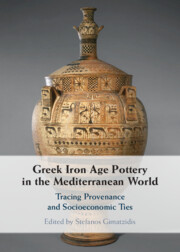Book contents
- Greek Iron Age Pottery in the Mediterranean World
- Greek Iron Age Pottery in the Mediterranean World
- Copyright page
- Contents
- Contributors
- Preface
- Abbreviations
- One Introduction to the Analysis of Greek Iron Age Pottery in the Mediterranean World
- Two Greek Iron Age Pottery in the Mediterranean World
- Three Greek Iron Age Pottery in the Mediterranean World
- Four The Social Context of Pottery Production, Exchange and Consumption in the Northern Aegean
- Five Geometric Pottery Production and Consumption in the Balkan Hinterland
- Six The Aegean Connection of East Locris
- Seven Early Iron Age Klazomenai
- Eight The Earliest Greek Colonisation in Campania
- Nine Late Geometric and Orientalising Pottery from Sicilian Naxos in Its Context
- Ten Early Greek Pottery on the Coast of Málaga, Andalusia, Spain
- Eleven Consumption of Geometric and Archaic Greek Pottery in the Emporion of Huelva (Tartessos, South-Western Spain)
- Twelve Greek Geometric Ceramics from Phoenician Utica
- Thirteen The Greek Geometric Pottery from the Tunisian Excavations at Utica
- Fourteen Early Iron Age Greek Pottery at Sidon
- Fifteen The Role of Aegean Imports and Aegeanizing Wares in the Phoenician Cemetery of al-Bass, Tyre
- Sixteen Concluding Remarks on Early Greek Pottery Production, Exchange and Consumption Overseas
- Catalogue of the NAA Samples and Results
- Appendix
- Index
- References
Four - The Social Context of Pottery Production, Exchange and Consumption in the Northern Aegean
Published online by Cambridge University Press: 30 May 2024
- Greek Iron Age Pottery in the Mediterranean World
- Greek Iron Age Pottery in the Mediterranean World
- Copyright page
- Contents
- Contributors
- Preface
- Abbreviations
- One Introduction to the Analysis of Greek Iron Age Pottery in the Mediterranean World
- Two Greek Iron Age Pottery in the Mediterranean World
- Three Greek Iron Age Pottery in the Mediterranean World
- Four The Social Context of Pottery Production, Exchange and Consumption in the Northern Aegean
- Five Geometric Pottery Production and Consumption in the Balkan Hinterland
- Six The Aegean Connection of East Locris
- Seven Early Iron Age Klazomenai
- Eight The Earliest Greek Colonisation in Campania
- Nine Late Geometric and Orientalising Pottery from Sicilian Naxos in Its Context
- Ten Early Greek Pottery on the Coast of Málaga, Andalusia, Spain
- Eleven Consumption of Geometric and Archaic Greek Pottery in the Emporion of Huelva (Tartessos, South-Western Spain)
- Twelve Greek Geometric Ceramics from Phoenician Utica
- Thirteen The Greek Geometric Pottery from the Tunisian Excavations at Utica
- Fourteen Early Iron Age Greek Pottery at Sidon
- Fifteen The Role of Aegean Imports and Aegeanizing Wares in the Phoenician Cemetery of al-Bass, Tyre
- Sixteen Concluding Remarks on Early Greek Pottery Production, Exchange and Consumption Overseas
- Catalogue of the NAA Samples and Results
- Appendix
- Index
- References
Summary
This paper examines the economic and other social relations that emerged in the colonial landscape of the northern Aegean through a new approach to pottery production, exchange and consumption. Our analytical data about pottery origins allow a new reconstruction of the exchange networks between the northern and central Aegean. The chapter suggests that the gradual increase in non-local pottery use along the northern Aegean shores and certain changes in local pottery production cannot be taken as a result of any growing colonial agency. They are interpreted instead as the low residue of locally driven transformations in the economic organisation of the northern Aegean. The new analytical data support a recently expressed view that these advances represent a pull factor of migration from central Greece towards its so-called northern Aegean periphery.
- Type
- Chapter
- Information
- Greek Iron Age Pottery in the Mediterranean WorldTracing Provenance and Socioeconomic Ties, pp. 85 - 153Publisher: Cambridge University PressPrint publication year: 2024

